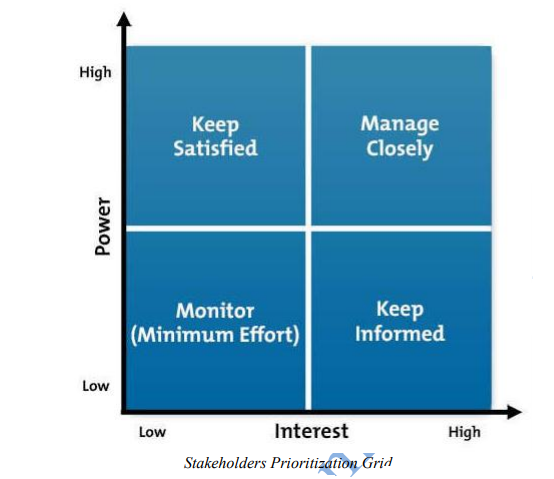Two of the challenges of performing stakeholder analysis are determining how stakeholders are affected by a firm‘s decisions and how much influence they have over the implementation of the decisions that are made. Many people have a tendency to fall into the trap of assessing all stakeholders as being important on both dimensions. In reality, not all stakeholders are affected in the same way and not all stakeholders have the same level of influence in determining what a firm does. Moreover, when stakeholder analysis is executed well, the resulting strategy has a better chance of succeeding, simply because the entities you might rely on in the implementation
phase were already involved in the strategy starting with the formulation phase. Thus, you now have a good idea of how to engage various stakeholders in all the stages of the P-O-L-C framework.
 Prioritize stakeholders.
Prioritize stakeholders.
When meeting with stakeholders, we recommend keeping notes in a table that estimates the stakeholders‘ influence and their interest in the project, and specifies their overall goals, and their objections to the project. Once you have organized information about stakeholders in this manner, you easily identify stakeholders on the basis of their power and interest in the project. Broadly speaking,
stakeholders can be organized into four groups:
- High Influence, High Interest: Some stakeholders might have a lot of influence over the project, and also be very interested in the project. It is vital to understand the viewpoints of such stakeholders–specifically what potential objections they might raise. Spend most time on these stakeholders.
- Low Influence, High Interest: Other stakeholders might have a lot of interest, but little real influence. Such stakeholders (if they are in favor of your project) can be valuable sources of information: they can get you access to documents relevant to your project, fill you in on the institutional history of past efforts in your project domain, and help you identify what the organizational challenges to the project will be. These are good stakeholders to meet with first, since each interaction is relatively low-risk.
- High Influence, Low Interest: Stakeholders with high power, but low interest need to be broadly satisfied. They won‘t pay attention to the fine print of your project, since they perceive the project as not affecting them. However, they have influence on whether the project will be a success: for example, they may have a vote during the approval process of a project. The goal of your interactions with this type of stakeholder should be to give them enough information about the project that they will not create obstacles for your project.
- Low Influence, Low Interest: You should spend less time with stakeholders who have little influence and little interest in the project. They aren‘t interested in what you are doing, and are not in a position to help you do it. One interesting thing about the suggestions generated by this model is that interest matters more than influence in determining the value of interactions between yourself and stakeholders. High interest, low influence stakeholders give you the ammunition and contextual information needed to make your case with the high influence stakeholders. Low interest, high influence stakeholders, in contrast, simply need merely to be won over or neutralized in a fairly superficial way. Projects will succeed or fail primarily based on the actions of people who care enough to defend or oppose them.

Understand stakeholder perspectives.
A good way to understand stakeholders is to conduct semi-structured interviews. Broad, open ended questions can be a good way of starting a conversation with stakeholders. Asking about ways that your project might go right, ways that it might go wrong, and what sources of data are available can be a good way of directing the conversation towards collaborative problem solving (DeBono, 1985). If a stakeholder has strong opinions about your project, it will come through during your conversation. Follow-up questions should focus on design alternatives or solutions to the problems raised by the stakeholder.
Conduct stakeholder interviews until you start to experience diminishing returns. If you are learning less and less from each interview, and you believe that you have met with representatives from all the business units that are affected by your project, than it is probably time to call it quits. Also, it is a good idea not to conduct all the stakeholder interviews at once. While it is a good idea to meet representatives from all the groups early in the process, it is often very fruitful to have more meetings as your thinking about the problem evolves. It also provides a chance to explain design solutions that you are considering on a one-to-one basis, rather than
present the solution to a group of people at once.
Incorporate stakeholder perspective into design.
Strong objections by powerful stakeholders will not go away just because you understand the reasoning behind the objections.
Part of the benefit of stakeholder interviews is accomplished simply by doing it well. It is not just that people like to be consulted, and that if you talk to them they will feel better about the process; a week of meetings with representatives of disparate business units will give you a much richer understanding of the corporate strategy, interdepartmental dynamics, and challenges a company faces than many of their employees have. This perspective will quite naturally seep into any designs you propose.
However, strong objections by powerful stakeholders will not go away just because you understand the reasoning behind the objections. If the objections are not addressed, they may jeopardize the success of the project. The preferable option is to design away the objections. Remember that the business units in a company represent the business concerns of a company. Try turning a negative on its head. For example, if the project is going to negatively impact the revenue of a particular business unit, try to imagine how the project could be redesigned so that that the business unit actually sees revenue increases. Not only will you be improving the odds of
your project succeeding; you will also be providing a solution that better meets the strategic goals of the company.
